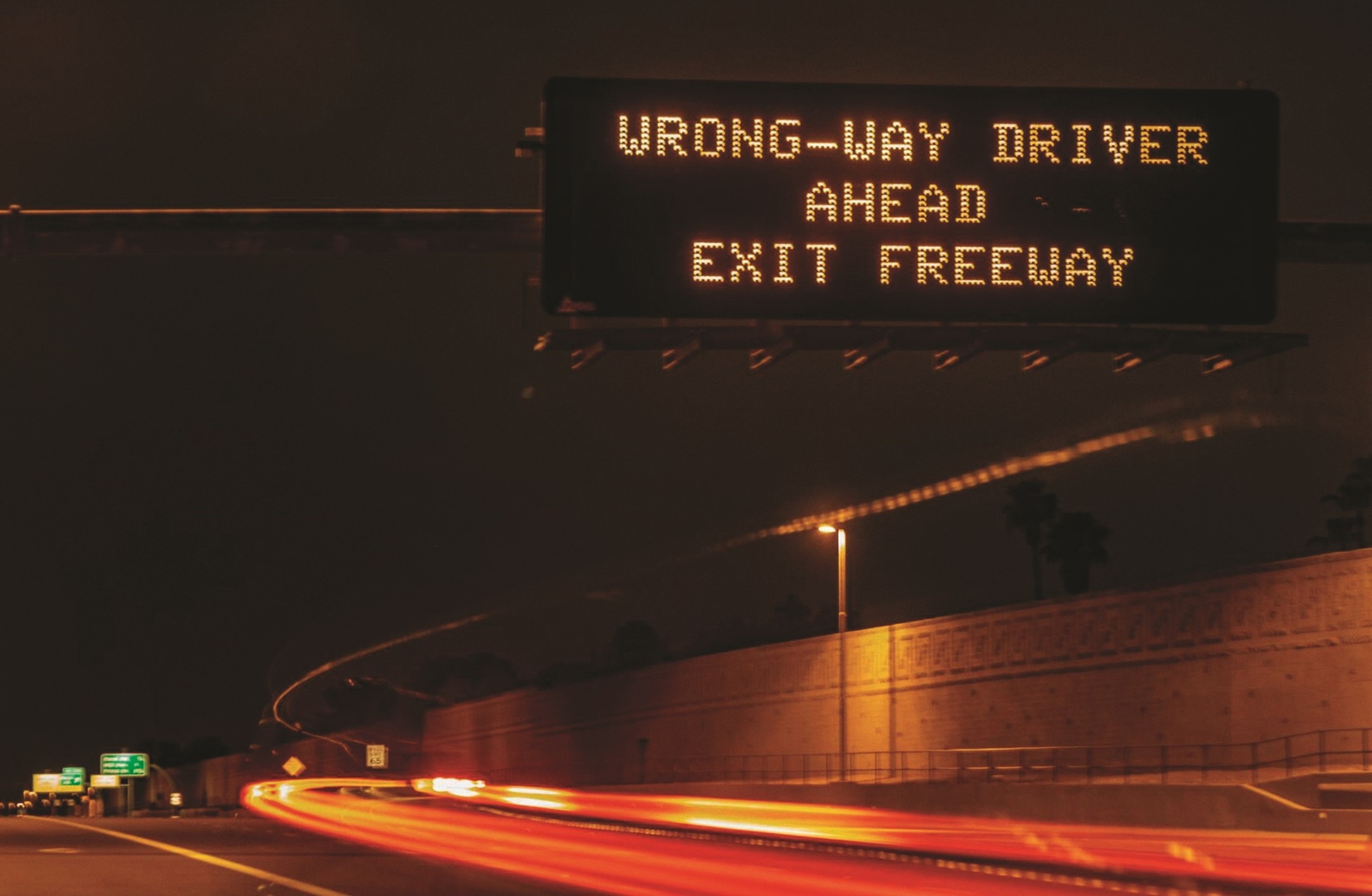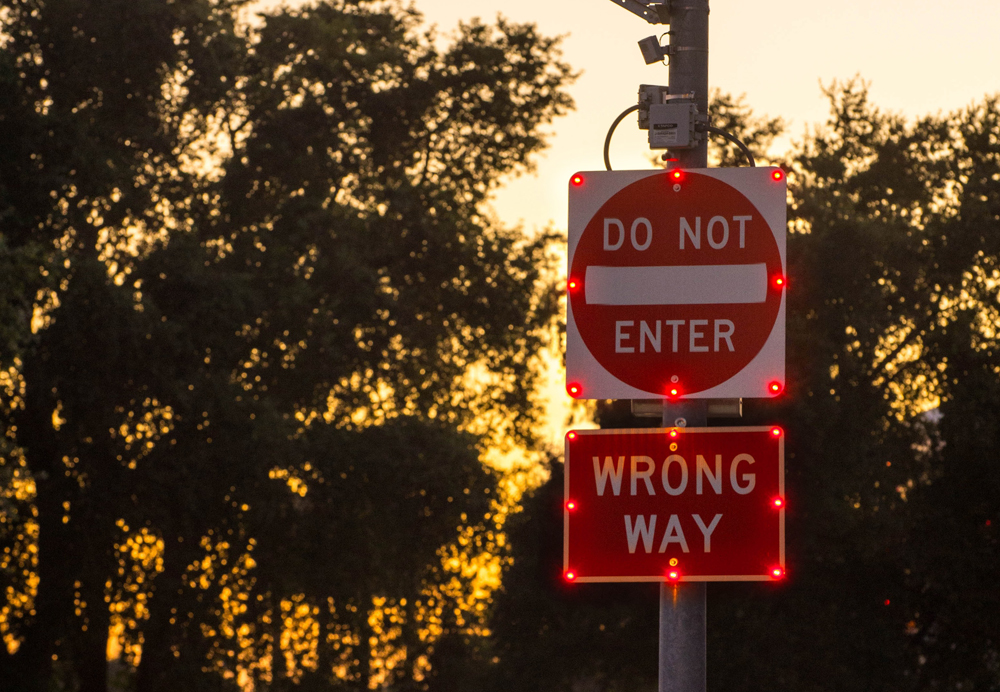
Wrong-way driving (WWD) is a remarkably innocuous term for incidents that all too often cause some of the worst accidents that emergency services have to deal with. Several US states are now taking steps to minimise the problem, as Alan Dron finds out.
You’re driving down a highway at night when you see approaching headlights. You initially assume they are merely those of an oncoming car on the opposite carriageway. It’s only when they are within 200 yards or so that you realise that the other driver is in fact on the wrong side of the road and heading straight for you.
If your reactions are quick, you avoid a horrific collision. If not…
Incidents of wrong-way driving (WWD) are, mercifully, relatively rare. But the fact that they frequently happen on divided highways – be they motorways, freeways or autostrada – where closing speeds can easily be in the order of 140mph (225km/h) means that if an impact occurs, it is often fatal.
A study by
Mitigating the problem
Several state Departments of Transportation (DOT) in the US are working to eliminate the problem, with new equipment coming on line not only to warn drivers that they are travelling in the wrong direction, but also to flash alerts to traffic management centres (TMCs) that can, in turn, alert the local police to intercept the car that has gone awry. The TMC can also use Variable Message Signs (
At first glance, it would seem to be remarkably difficult for such incidents to occur, given the plethora of traffic signs on modern roads – especially on divided highways and on the ramps which go on and off them. However, a large percentage of WWD incidents in the US are caused by drivers whose cognitive functions are impaired.
Arizona DOT says that two out of three wrong-way crashes are caused by impaired drivers and often these drivers have blood-alcohol levels more than twice the legal limit. Measures to address the threat of wrong-way drivers have included installation of a first-of-its-kind thermal camera detection system pilot project on I-17.
Installation of the $3.7 million project began in August 2017 along a 15-mile stretch of I-17, from the I-10 ‘Stack’ interchange north to the Loop 101 interchange in north Phoenix. “Installation of 90 thermal cameras, manufactured by FLIR, and other components (including fibre-optic cable, hardware in control cabinets and new background-illuminated wrong-way signs for placement along exit ramps) was completed in late November,” explained Arizona DOT spokesman Doug Nintzel. “The system’s operation will be researched over approximately the next year.”
Alcohol and age
Melisa Finley, a research engineer at
“Sometimes as we get older, our vision has some degradation and it’s much more of a task just to control the vehicle to get from A to B,” she said.
That meant that sometimes the elderly were so focused on the task of driving that they blocked out visual cues warning that they were heading in the wrong direction. Statistics showed that WWD incidents accounted for around 3% of high-speed crashes on divided highways, she said. And while the overall number of crashes was dropping, the incidence of WWD was stable, or even slightly increasing in the US.
However, the majority of drivers that started travelling in the wrong direction disappeared before police could intercept them, she added. As most WWD incidents happened at night when traffic volumes were lower, some drivers realised their mistake and managed to exit at the next ramp before a collision occurred.
Finding a remedy
Several companies in the ITS sector have stepped up to try to remedy, or at least mitigate, the WWD problem.
Announced last November, it leverages the high-definition video stream from ISS’s RTMS Sx-300 HDCAM radar product, which combines radar and a camera in a single housing. The camera is triggered when the radar detects a vehicle heading the wrong way, giving visual confirmation of the incident.
This can be hooked up to pole-mounted or in-pavement flashing light systems to catch the driver’s attention, as well as triggering alerts on nearby VMS and sending a message by e-mail or text to a traffic management centre.
“We have beta installations out there,” said ISS spokesperson Lisa Chubb. “We’ve had very positive feedback. We installed one in Colorado and caught a live event within the first week.” Orders for the device have been received from several US state DOTs, she added, which were due to start being fulfilled in January.
Wilsonville, Oregon-based FLIR Systems, meanwhile, is using its thermal imaging cameras combined with video analytics (either onboard or external), which are typically positioned on highway exit ramps to detect vehicles moving against the normal direction of traffic.
A flashing beacon along the exit ramp can be activated upon detection to warn the WWD driver of his mistake. Again, warning messages can instantly be posted on nearby VMS boards, while the detection system can also close off nearby highway entries by means of red lights.
Driver behaviour
Texas DOT has increased warning signage and is ensuring road markings are in place, while introducing new systems such as flashing signs, said Texas A&M Transportation Institute’s Finley. She has recently completed a research project into how connected vehicles could help solve the WWD problem. Such vehicles, equipped with dedicated short-range communication (DSRC) devices, could trigger roadside sensors that would immediately send a warning message to the offending vehicle as well as transmitting a similar warning to other vehicles in the area. This method would become increasingly viable as DSRC market penetration increased, she said.However, Arizona’s Nintzel cautioned that no amount of technology could solve the major underlying factor behind WWDs, namely drunk drivers getting behind the wheel. “This is first and foremost a driver behaviour issue,” he concluded. Nevada: learning the hard way
In Nevada, Rod Schilling, assistant chief for traffic operations at the state’s DOT, said that from 2005-15, there were just over 40 deaths in Nevada due to WWD incidents. They tended to be either on interstate highways or US routes.
Contractors are scheduled to install Nevada’s first WWD system in March on US395 in the North Valleys of Reno, with the system due to be tested from this June.
Made by Viion, it will incorporate a radar, camera and large rectangular rapid flashing sign warning the driver of his error and be placed within 250ft of the entrance to the ramp.
The DOT wants an alert of any driver entering the ramp in the wrong direction to be sent automatically to the state’s Department of Public Safety, to allow a highway patrol vehicle to be dispatched to the scene as quickly as possible.
The radar will provide the initial warning that a vehicle is heading the wrong way down the ramp. This will then start the camera, which will provide confirmation that the driver has not realised his error and immediately turned around. The pan-tilt-zoom CCTV camera will be able to be mounted on an 80ft pole. “We’re working with the University of Reno to do all the reporting,” said Schilling. “They will work with the DOT to collect the data and compile a bi-annual report to the Federal Highways Administration (FHA).”
The systems are planned to be installed at several locations on US395 in the north of Nevada, as well as others around Las Vegas, further south.
Nevada DOT has identified 26 locations in the state where the WWD systems may be installed, including interstate highways I-15, I-80 and I-580, as well as US95 and US395.
The DOT had to get special permission from the FHA for the experiment, as the system is not currently an approved traffic control device.











